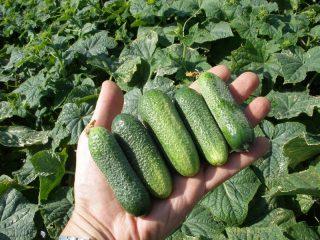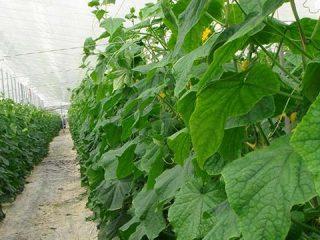Content
Cucumbers are one of the most common vegetables in the world. Today, there are many selected species of cucumbers, as well as numerous hybrids resulting from mutation of varieties. In order for a vegetable to bear fruit and produce seeds, the cucumber must be pollinated.
Pollination types
The process of pollination itself is tantamount to fertilization - pollen from a male flower must get onto a female one. As a result of this, pollination will occur and an ovary (future cucumber) is formed. Therefore, pollination is very important, without this process, the so-called barren flowers are formed - inflorescences that do not turn into fruits, but simply dry out.
There are three types of cucumbers:
- parthenocarpic (self-pollinated);
- bee-pollinated;
- not requiring pollination.
The latter is a selected hybrid of cucumbers, created specifically for growing indoors (in a greenhouse). These varieties have only female inflorescences, the number of barren flowers is minimized.
Natural pollination of cucumbers can be done in several ways:
- with the help of the wind;
- through streams of water;
- pollination by insects.
In addition to the natural method, artificial pollination of cucumbers is often used. This is necessary when vegetables are planted in a closed greenhouse or the number of insects (bees) is not enough to fully pollinate all flowers.
How does cucumber pollination work?
In order to fully understand the process of pollination of cucumbers, you need to learn to distinguish male from female inflorescences. Male flowers are arranged in groups in one axil of the whip, while female flowers grow separately. In addition, the male flower has a stamen, but no pistils, while the female, on the contrary, has only pistils.
For proper pollination, pollen from the stamen of the male inflorescence must fall on the pollen of the pistils of the female flower. This is exactly the job that bees do. But these insects cannot always cope, they interfere:
- closed greenhouses (when the outside temperature is too low, for example);
- strong winds;
- rains;
- cloudy weather is also not conducive to the flight of bees.
In these cases, bee-pollinated crop varieties need human help - artificial pollination. It can be done in several ways, here are two of them:
- Pick the male cucumber flower and bring it to the female, while gently holding the stamen along the pistils, from top to bottom.
- Arm yourself with a soft brush for painting and with it transfer pollen from male cucumber flowers to female ones.
How to choose cucumber seeds
When buying cucumber seeds, you need to build on not only the qualities of the finished fruit. When choosing a variety, several factors are taken into account at once. Weather conditions, type of soil, possibility of watering, type of treatment for diseases - all this is analyzed in a complex.
If the choice fell on bee-pollinated varieties, you first need to think about the possibility of full-fledged natural pollination of cucumbers. In this case, it is better if the owner has bees on the same plot of land.In extreme cases, hives with insects should be located in the immediate vicinity of the vegetable garden. If the number of bees is insufficient, the bee-pollinated varieties will not give the expected yield, there will be many barren flowers instead of cucumbers.
The situation can be corrected by a mechanical (artificial method). It was written about him earlier.
The best varieties of bee-pollinated cucumbers
Each gardener has his favorite varieties of cucumbers: someone prefers more productive hybrids, for someone resistance to diseases, taste characteristics are important. Below is a list of varieties, the seeds of which are the most demanded:
"Abundant"
Differs in high productivity. Up to 5.8 kg of cucumber can be removed from each square meter. The hybrid is resistant to the most common diseases of cucumbers: powdery mildew and cladosporiosis. The bushes of this variety are small, the fruits rarely reach 100 grams. Taste qualities of the variety are high, cucumber "Izobilny" is perfect for salads and fresh consumption. This bee-pollinated variety is intended both for planting in open ground and for greenhouse cultivation. It is recommended to sow hybrid seeds only after the threat of frost - this cucumber loves warmth (a suitable soil temperature is above 11-12 degrees).
"F1 TSKHA-2693"
It has large fruits weighing up to 250 grams. The cucumber is easy to distinguish by its fairly large tubercles and white thorns. The bushes of the plant are of medium climbing, the cucumber has a predominance of female flowers. The yield is very high - 26-28 kg per square meter. The taste characteristics of the variety are also up to the mark - it is perfect for both salads and preservation. Cucumber "F 1 ТСХА-2693" can be planted both in greenhouses and in open ground, it is resistant to olive spot and ordinary cucumber mosaic.
"Avangard"
Differs in early maturity, the fruiting of the hybrid occurs 36-38 days after sowing. The bushes of this variety are distinguished by branching and bright green leaves, the cucumbers themselves are small (90-150 grams), with large pimples, without bitterness. The plant is resistant to downy mildew, suitable for planting in open and closed ground. Avangard cucumber is tasty both fresh and canned (pickled).
"Abruzze"
This is a variety that stands out for its long (up to 45 cm) light green fruits. There are no bumps on the cucumbers, but there is a slight ribbing. Bushes of medium height with green leaves and good side shoots. Cucumber is resistant to diseases, including powdery mildew. Fruiting of the variety occurs on the 65th day after sowing. You can plant Abruzze cucumbers even in greenhouse, even into the ground. The yield reaches 10 kg / m².
Strengths of bee-pollinated cucumbers
Bee-pollinated crops have many "fans" among gardeners and summer residents. And this is not surprising, such recognition is well deserved, because these varieties of cucumbers have the following advantages:
- unpretentious requirements for the illumination of a greenhouse or greenhouse;
- high degree of early maturity;
- high taste characteristics and versatility (cucumbers are not bitter, they are perfectly amenable to salting);
- increased productivity;
- profitability (the funds spent on the purchase of seeds will return with surplus after the harvest of cucumbers);
- disease resistance;
- good reaction of the variety to temperature extremes.
With all the advantages, bee-pollinated varieties have a couple of disadvantages. The first of these is the necessary availability of bees in sufficient numbers. In an open area of ground, this problem can still be dealt with, but in a greenhouse you will have to manually pollinate cucumbers.
The second disadvantage of this variety of cucumbers is that for full pollination, the proportion of male and female inflorescences must be observed. This implies the purchase and overseeding of cucumber varieties with a predominance of male flowers.
Well-known breeding companies put several such seeds in each bag of seeds of bee-pollinated varieties of cucumber.They can be distinguished by their color in a different color, while the packaging will say about this feature of the seeds.
In addition, there are a number of less significant disadvantages of bee-pollinated varieties:
- low bushes with thin leaves when growing greenhouse hybrids;
- increased consumption of planting material;
- large labor costs for caring for cucumbers;
- the need to keep or attract pollinating insects.
Despite the disadvantages, bee-pollinated varieties are in the lead in the total number of purchased seeds. These cucumbers are distinguished by good germination and high productivity, probably, these are still the main qualities of a vegetable that gardeners take into account.
Preparing seeds for planting
Cucumber seeds can be purchased from a breeder or harvested by yourself. Purchased seeds undergo complex processing, they are already ready for planting. But you will have to work with your own collected seeds. There are a number of rules and guidelines here:
- You can plant cucumber seeds collected two years ago. Last year's are not suitable for planting.
- For the initial selection, you need to carefully examine the seeds: they must be even, whole, the same color. Defective seeds are discarded.
- Seeds are sorted by size into three categories: small, large and medium. You need to plant seeds from the same category together.
- Identify empty seeds. To do this, they are placed in salted water (1.5 teaspoons of salt are added to a glass of water). Stir water with seeds and leave for a few minutes. The floating seeds need to be thrown away - nothing will grow out of them.
- The seed must be disinfected. For this, a solution of boric acid or manganese is used. First, the seeds are heated in the sun, in a radiator or in a thermos with warm water. Then it is placed in a disinfecting solution, kept, washed with running water. Ultraviolet lamp treatment is very effective.
- Wood ash will help to saturate the seeds with the necessary trace elements. A tablespoon of ash is stirred in 0.5 liters of water. The seeds placed in the mixture are left for a day.
- In an amicable way, the seed must also be hardened. First, the seeds are placed in wet sand and kept at a temperature of +25 degrees for a day until they swell, the next stage is a refrigerator, where the seeds should lie for 2-3 days.
After all the stages, the seeds are ready for planting.
Planting bee-pollinated cucumbers
In addition to seeds, the soil also needs preparation. If it is a greenhouse, the soil from it must be mixed with humus and wood ash. When sowing in open ground, grooves must be prepared, their location and depth depend on the methods of watering, the bushiness of the cucumber and the height of the lashes. Fertilizer needs to be added to the ground, bird droppings are well suited from natural ones.
It is important to consider that any cucumbers do not like transplants, they are transferred to a permanent place along with the soil. therefore seedlings of cucumbers it is better to plant in disposable peat or paper cups larger than 10 cm in diameter.
Cucumbers are planted in a heated greenhouse in late February and early March. Seedlings should be planted in open ground only when stable heat comes. Cucumbers do not like temperatures below 17 degrees.
Bee-pollinated varieties are the best choice for owners with their own bees or an apiary near the site. To attract insects to a greenhouse with cucumbers, you need to open it in sunny weather, and spray the bushes with weak sugar syrup. You can buy cucumber seeds, the range of species and hybrids for today is simply huge, or you can collect them from your harvest, observing the rules for preparing seeds for planting.





















